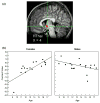Probing the neural correlates of anticipated peer evaluation in adolescence
- PMID: 19630890
- PMCID: PMC2791675
- DOI: 10.1111/j.1467-8624.2009.01313.x
Probing the neural correlates of anticipated peer evaluation in adolescence
Abstract
Neural correlates of social-cognition were assessed in 9- to- 17-year-olds (N = 34) using functional magnetic resonance imaging. Participants appraised how unfamiliar peers they had previously identified as being of high or low interest would evaluate them for an anticipated online chat session. Differential age- and sex-related activation patterns emerged in several regions previously implicated in affective processing. These included the ventral striatum, hippocampus, hypothalamus, and insula. In general, activation patterns shifted with age in older relative to younger females but showed no association with age in males. Relating these neural response patterns to changes in adolescent social-cognition enriches theories of adolescent social development through enhanced neurobiological understanding of social behavior.
Figures





Similar articles
-
Friends and foes: Neural correlates of prosocial decisions with peers in adolescence.Neuropsychologia. 2019 Jun;129:153-163. doi: 10.1016/j.neuropsychologia.2019.03.004. Epub 2019 Mar 12. Neuropsychologia. 2019. PMID: 30871971
-
Early-Childhood Social Reticence Predicts Brain Function in Preadolescent Youths During Distinct Forms of Peer Evaluation.Psychol Sci. 2016 Jun;27(6):821-35. doi: 10.1177/0956797616638319. Epub 2016 May 5. Psychol Sci. 2016. PMID: 27150109 Free PMC article.
-
Neural correlates of adolescents' viewing of parents' and peers' emotions: Associations with risk-taking behavior and risky peer affiliations.Soc Neurosci. 2015;10(6):592-604. doi: 10.1080/17470919.2015.1022216. Epub 2015 Apr 15. Soc Neurosci. 2015. PMID: 25874749 Free PMC article.
-
Expanding understanding of adolescent neural sensitivity to peers: Using social information processing theory to generate new lines of research.Dev Cogn Neurosci. 2024 Jun;67:101395. doi: 10.1016/j.dcn.2024.101395. Epub 2024 May 24. Dev Cogn Neurosci. 2024. PMID: 38823235 Free PMC article. Review.
-
Normal functional imaging of the basal ganglia.Epileptic Disord. 2002 Dec;4 Suppl 3:S23-30. Epileptic Disord. 2002. PMID: 12495872 Review.
Cited by
-
Social anxiety disorder in adolescence: How developmental cognitive neuroscience findings may shape understanding and interventions for psychopathology.Dev Cogn Neurosci. 2015 Jun;13:11-20. doi: 10.1016/j.dcn.2015.02.002. Epub 2015 Feb 28. Dev Cogn Neurosci. 2015. PMID: 25818181 Free PMC article. Review.
-
Adolescent and adult risk-taking in virtual social contexts.Front Psychol. 2014 Dec 18;5:1476. doi: 10.3389/fpsyg.2014.01476. eCollection 2014. Front Psychol. 2014. PMID: 25566150 Free PMC article.
-
Temperament and Parenting Styles in Early Childhood Differentially Influence Neural Response to Peer Evaluation in Adolescence.J Abnorm Child Psychol. 2015 Jul;43(5):863-74. doi: 10.1007/s10802-015-9973-2. J Abnorm Child Psychol. 2015. PMID: 25588884 Free PMC article.
-
Neural sensitivity to peer feedback and depression symptoms in adolescents: a 2-year multiwave longitudinal study.J Child Psychol Psychiatry. 2023 Feb;64(2):254-264. doi: 10.1111/jcpp.13690. Epub 2022 Sep 9. J Child Psychol Psychiatry. 2023. PMID: 36082818 Free PMC article.
-
Neural substrates of the influence of emotional cues on cognitive control in risk-taking adolescents.Dev Cogn Neurosci. 2018 Jun;31:20-34. doi: 10.1016/j.dcn.2018.04.007. Epub 2018 Apr 22. Dev Cogn Neurosci. 2018. PMID: 29729493 Free PMC article.
References
-
- Aharon I, Etcoff N, Ariely D, Chabris CF, O’Connor E, Breiter HC. Beautiful faces have variable reward value: fMRI and behavioral evidence. Neuron. 2001;32:537–551. - PubMed
-
- Anderson P, Moris R, Amaral D, Bliss T, O’Keefe J. Historical perspective: Proposed functions, biological characteristics, and neurobiological models of the hippocampus. In: Anderson P, Moris R, Amaral D, Bliss T, O’Keefe J, editors. The hippocampus book. New York: Oxford University Press; 2007. pp. 9–36.
-
- Aron A, Fisher H, Mashek DJ, Strong G, Li H, Brown LL. Reward, motivation, and emotion systems associated with early-stage intense romantic love. Journal of Neurophysiology. 2005;94:327–337. - PubMed
-
- Baumeister RF, Leary MR. The need to belong: Desire for interpersonal attachments as a fundamental human motivation. Psychological Bulletin. 1995;117:497–529. - PubMed
Publication types
MeSH terms
Grants and funding
LinkOut - more resources
Full Text Sources

